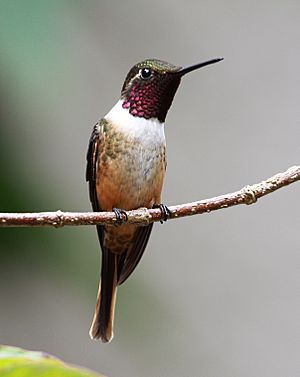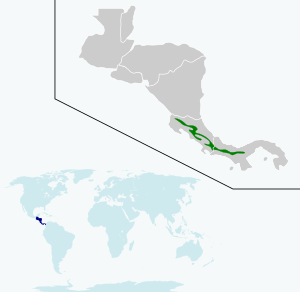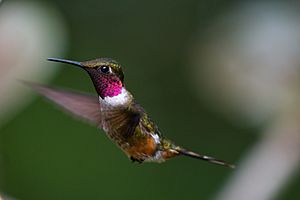Magenta-throated woodstar facts for kids
Quick facts for kids Magenta-throated woodstar |
|
|---|---|
 |
|
| Male in Costa Rica | |
 |
|
| Female | |
| Conservation status | |
| Scientific classification | |
| Genus: |
Philodice
|
| Species: |
bryantae
|
 |
|
| Range of P. bryantae | |
| Synonyms | |
|
Calliphlox bryantae |
|
The magenta-throated woodstar (Philodice bryantae) is a tiny, colorful hummingbird. It lives in the forests of Costa Rica and Panama. This bird is known for the bright purple patch on the male's throat, which looks like a shiny jewel!
About the Magenta-Throated Woodstar
How Scientists Classify This Bird
Scientists like to group animals to understand them better. The magenta-throated woodstar is a type of hummingbird. It used to be in different groups, but now many experts place it in the Philodice group. It shares this group with another bird called the purple-throated woodstar. This bird is also "monotypic," meaning it's the only species in its specific subgroup.
What Does This Hummingbird Look Like?
Male magenta-throated woodstars are about 9 centimeters (3.5 inches) long. They weigh around 3.3 grams, which is super light! Females are a bit smaller, about 7.5 centimeters (3 inches) long, and weigh about 3.5 grams.
Both males and females have a short, straight, black beak. They also have a small white spot right behind each eye. Their upper bodies are a shiny bronzy-green color. They also have a white band across their upper chest. The male's white band is wider and brighter.
Male and Female Differences
Adult males have a metallic purple patch on their throat. This patch is called a gorget. They also have a green chest and sides, with a reddish-brown belly. The male's tail feathers are interesting. The middle ones are short, and the ones further out get longer. They are black with reddish-brown on the inside.
Females have a light, creamy throat. Their chest and sides are green, sometimes with a little reddish-brown mixed in. The female's tail feathers are different from the male's. The middle and outer feathers are shorter than the ones in between. This gives their tail a "double rounded" look. The feathers are reddish-brown with a black band and light cinnamon tips.
Young birds look a lot like the adult female. They are just a bit paler underneath.
Where Do Magenta-Throated Woodstars Live?
You can find the magenta-throated woodstar from northern Costa Rica all the way to western Panama. They mostly live on the Pacific side of these countries.
They prefer places that are partly open, like the edges of forests. You might see them in clearings, thin woodlands, or even shrubby pastures. They live in mountains, usually between 700 and 1850 meters (about 2,300 to 6,000 feet) high in Costa Rica. In Panama, they are found between 1100 and 1750 meters (about 3,600 to 5,700 feet).
Behavior and Life Cycle
How They Move Around
Magenta-throated woodstars seem to move around locally. This means they might only be in certain places during part of the year. Scientists are still learning more about their exact travel patterns.
What Do They Eat?
These hummingbirds love to drink nectar from many different kinds of flowers, shrubs, and trees. They also catch small bugs, like spiders and insects. They do this by flying out from a perch to snatch them in the air. Sometimes, they pick bugs off leaves.
Both male and female woodstars might try to protect their feeding spots. This can lead to them chasing other birds away. When a male is feeding, he usually keeps his long tail tucked in. But if he's being aggressive, he'll open his tail wide!
Reproduction and Life Cycle
In Costa Rica, the magenta-throated woodstar's breeding season is from November to March or April. We don't know much about their breeding in Panama yet.
Males perform special diving flights to attract females. They might do this alone or in small groups. Scientists haven't found or described their nests yet. This means we don't know how long the eggs take to hatch or when the young birds leave the nest.
What Sounds Do They Make?
The magenta-throated woodstar's song is a fast mix of sputtering and gurgling sounds. They also make different calls. One call is a low, dry rolling sound, like "drr." Another is a dry "cht." When they are chasing other birds, they make a low, whistled "tew."
Conservation Status
The IUCN (International Union for Conservation of Nature) keeps track of how many animals are left. They first thought the magenta-throated woodstar was "Near Threatened." But since 2004, they have changed its status to "Least Concern." This means they are not currently worried about it going extinct.
Even though it lives in a specific area, its population is estimated to be between 20,000 and 50,000 adult birds. However, this number is thought to be slowly decreasing. The good news is that these birds are locally common, at least during certain times of the year. They also seem to be okay with some forest areas being cleared.
See also
 In Spanish: Colibrí magenta para niños
In Spanish: Colibrí magenta para niños



